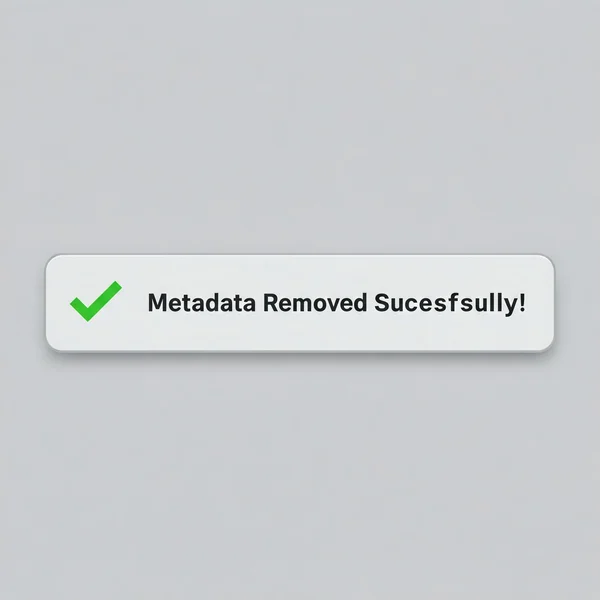Top 5 Image Metadata Risks: Protect Your Online Privacy Now
Every time you snap a photo with your digital camera or smartphone, you're capturing more than just a moment. Hidden within that image file is a trove of data known as metadata. While some of this information can be useful, it often carries unseen dangers that can compromise your online privacy and security. What can metadata reveal about you, and why should you be concerned? This article unveils the top 5 image metadata risks and explains why actively managing this data is crucial for your digital safety. You can start protecting yourself today by using an effective online metadata removal tool.
Risk 1: Inadvertent Geolocation Exposure & Stalking Threats
One of the most significant photo privacy threats comes from geolocation metadata. Many modern devices automatically embed GPS coordinates into your photos, pinpointing the exact location where each picture was taken.

How EXIF GPS Tags Can Pinpoint Your Exact Location
This EXIF data, specifically GPS tags, can be incredibly precise. Sharing a photo online without removing this information is like broadcasting your physical whereabouts. While you might share a vacation photo innocently, that embedded hidden information could reveal your home address if taken there, your favorite hangout spots, or even your daily routines. Does EXIF data show location? Absolutely, and with alarming accuracy.
Real-World Examples of Geotagging Dangers (Privacy Invasion)
There have been numerous instances where individuals faced real-world consequences due to geotagged photos. Stalkers have used this information to track victims, and burglars have identified when people are away from home. The seemingly harmless act of sharing a photo can turn into a serious online security risk if geolocation metadata isn't properly managed.
Protecting Your Family: Children's Photos and Location Data
The risk is even more pronounced when it comes to photos of children. Sharing images of your kids with embedded location data can unintentionally reveal their school, playground, or home address to anyone who accesses the photo. Protecting your family's privacy means being diligent about geolocation metadata in every shared image.
Risk 2: Revealing Personal & Equipment Details Unknowingly
Beyond location, image metadata can expose a surprising amount of personal details exposure and information about the equipment used.
Camera Models, Serial Numbers, and Software Versions in EXIF
Your photos' EXIF data often includes the make and model of your camera or smartphone, lens details, and even the unique serial number of the device. Software versions used for editing can also be logged. While this might seem trivial, such hidden information can be compiled by tech-savvy individuals.
Owner Names and Copyright Info (If Not Intended for Public)
Sometimes, metadata fields might contain the photographer's name or copyright information that wasn't intended for public viewing with that specific image or in that specific context. Or worse, it might contain default information from a previous user of the camera. Ensuring this EXIF data security is properly handled is important.
How This Information Can Be Exploited (Theft, Profiling)
Knowledge of high-value equipment (from serial numbers) could potentially make individuals targets for theft. More broadly, aggregated equipment and software data can contribute to a more detailed digital profile of an individual, which, combined with other data points, can be used for various profiling purposes. Consider using a metadata cleaner to remove such details.
Risk 3: Copyright & Intellectual Property Vulnerabilities
For creators and professionals, unmanaged metadata can lead to copyright vulnerabilities and issues with intellectual property.

Accidental Disclosure of Unfinished Work or Client Details
Imagine a photographer accidentally sharing an image from a confidential client shoot, and the metadata contains client names, project codes, or notes about the unfinished work. This personal details exposure within metadata can lead to breaches of non-disclosure agreements or damage client relationships.
Misleading Metadata Affecting Licensing or Attribution
Incorrect or missing copyright information in metadata can complicate licensing and proper attribution. While metadata alone doesn't grant copyright, its absence or incorrectness can create confusion and disputes. Conversely, sometimes old, irrelevant copyright information might persist, creating a misleading impression.
Protecting Your Creative Assets by Cleaning Metadata
Proactively managing and, where necessary, removing certain metadata elements is a key step in protecting your creative assets. This ensures that only intended information is shared alongside your images. An effective metadata removal process is crucial here.
Risk 4: Social Engineering & Targeted Attack Fuel
Seemingly innocuous pieces of metadata can be aggregated and used by malicious actors to fuel social engineering schemes and targeted attacks.
How Attackers Use Metadata to Build Victim Profiles
Attackers are adept at piecing together fragments of information. What can metadata reveal to them? It can show patterns: when you're typically home or away (from geotags), what kind of technology you use (from equipment details), or even clues about your social connections if photos are frequently taken with the same people in identifiable locations.
Identifying Routines, Habits, and Connections via Photo Data
A series of photos shared over time, each containing metadata, can paint a detailed picture of your life. This hidden information about routines, habits, and frequently visited locations can make you a more predictable and vulnerable target for those with malicious intent.
Metadata as a Starting Point for Phishing or Scams
Information gleaned from metadata (e.g., recent vacation spots, new tech purchases) can be used to craft highly convincing phishing emails or scam messages, significantly increasing the attacker's chances of success. Protecting your online security involves minimizing such data leakage.
Risk 5: Digital Footprint & Profiling Concerns
Every piece of data you leave online contributes to your digital footprint. Metadata from your photos plays a significant role in this, leading to profiling concerns.

Aggregated Metadata Building a Detailed Personal Profile
Data brokers and advertisers can collect and aggregate metadata from countless images shared across the web. This allows them to build surprisingly detailed profiles about individuals – their interests, lifestyle, wealth level, travel habits, and more, all without direct consent for such profiling based on EXIF data.
Implications for Long-Term Privacy and Data Brokerage
This compiled digital footprint can have long-term privacy implications. Your data could be sold, traded, or used in ways you never envisioned or agreed to, affecting everything from the ads you see to potentially more significant life opportunities or biases.
Taking Control of Your Online Image Identity
Managing your image metadata is a proactive step towards taking control of your online identity. By deciding what information accompanies your photos, you reduce the data points available for others to build profiles about you, enhancing your online privacy.
How to Mitigate These Image Metadata Risks Effectively
Understanding these image metadata risks is the first step. The next is taking action to mitigate them. What does cleaning metadata do, and how can you do it effectively?
Understanding What "Cleaning Metadata" Really Does
"Cleaning" or "scrubbing" metadata involves removing or altering the embedded data within an image file. This can range from deleting specific tags (like GPS coordinates) to stripping almost all non-essential information, leaving just the visual image itself.
Manually Checking and Removing Data
Operating systems offer some built-in ways to view and sometimes remove certain metadata properties (often under "File Properties" or "Get Info"). However, these methods can be cumbersome, may not remove all types of metadata (especially deeper EXIF data), and are impractical for multiple files.
Using a Reliable Metadata Remover Tool
The most efficient and thorough way to address these risks is by using a dedicated metadata remover tool. These tools are designed to identify and erase metadata comprehensively. For a quick and easy solution, an online EXIF remover can process your images and strip unwanted data before you share them.

Your Next Step to Image Privacy & Security
The image metadata risks are real and varied, impacting everything from your physical safety due to geolocation metadata exposure to your broader online privacy through profiling. Leaving this hidden information unchecked is an unnecessary gamble with your personal data and EXIF data security.
The good news is that you can take control. By understanding these threats and utilizing tools to manage and remove image metadata, you significantly enhance your digital safety. Don't wait for a privacy breach to take action. Which metadata risk worries you the most? Share your thoughts in the comments below, and take your first step towards better photo privacy threat protection by checking your images today with a trusted metadata removal service.
Common Questions About Image Metadata Dangers
Here are answers to some common questions about the dangers lurking in your image metadata:
Can simply taking a screenshot remove metadata?
It depends. Taking a screenshot can sometimes strip some of the original metadata from a photo, but not always, and often not completely. The new screenshot file will have its own metadata (like creation date, device used for the screenshot). It's not a foolproof method for ensuring all sensitive EXIF data from the original image is gone.
Does social media automatically remove all risky metadata?
Often, but not always reliably or completely. Many social media platforms do strip some metadata (like GPS) upon upload to protect user privacy. However, their policies can change, they might not remove all types of metadata (e.g., camera information), and relying solely on them can be risky. For guaranteed metadata removal, it's best to clean your images before uploading.
What is the most dangerous type of metadata in a photo?
While subjective, geolocation metadata (GPS coordinates) is often considered one of the most dangerous types due to the immediate physical safety risks it can pose (stalking, burglary). However, other hidden information like personally identifiable details or data that can be used for social engineering also presents significant image metadata risks.
How can I check what metadata my photos contain?
You can often view basic metadata by right-clicking an image file on your computer and selecting "Properties" (Windows) or "Get Info" (Mac). For a more detailed view of EXIF data and other metadata, dedicated EXIF viewer software or our online service can be used.
Is removing metadata difficult or time-consuming?
Not anymore! While manual methods can be tedious, using a dedicated metadata cleaner or an online service makes it very simple and quick. Many tools, like our online photo metadata remover, allow you to upload an image and delete metadata with just a few clicks.